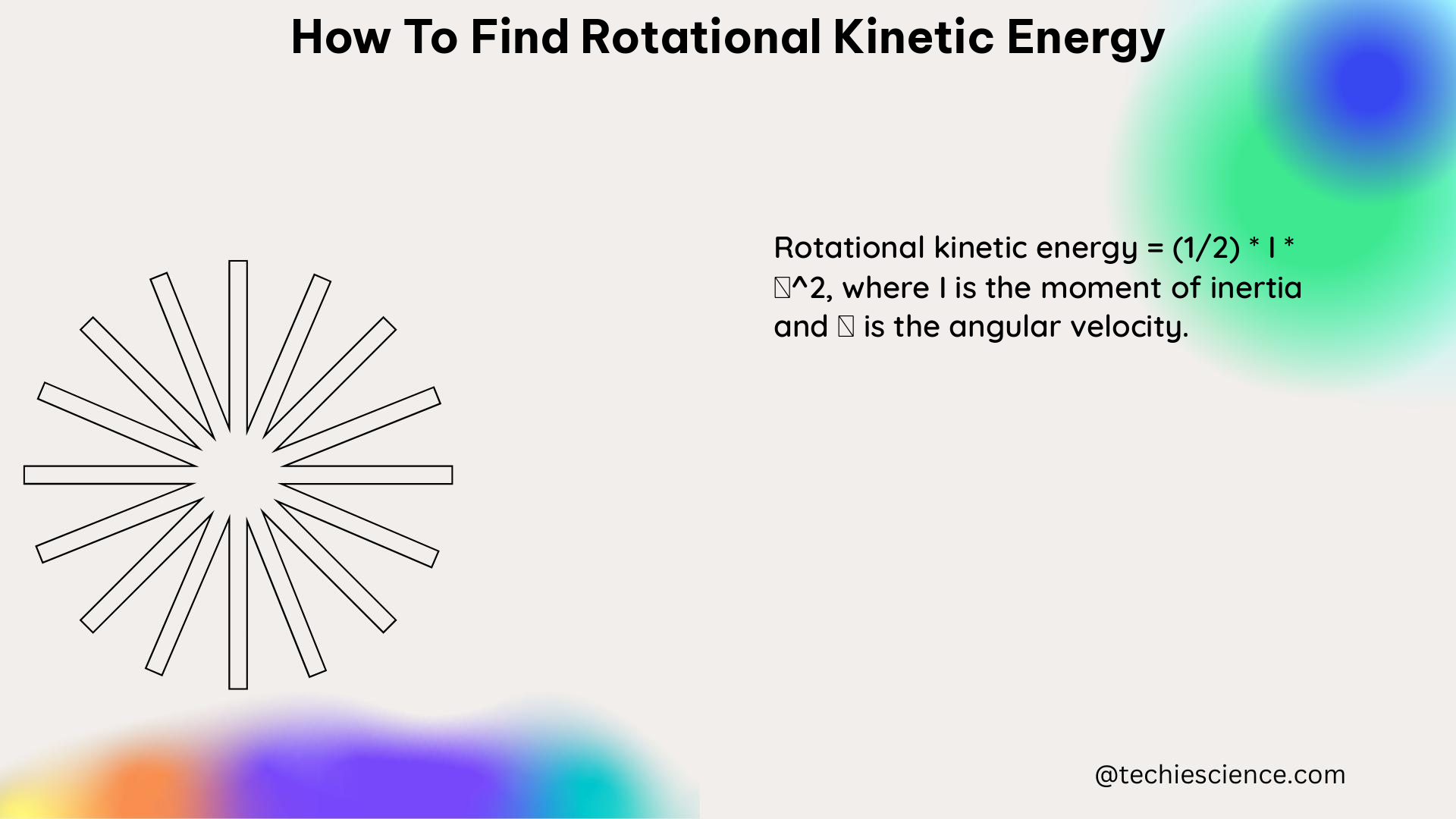Rotational kinetic energy is the energy an object possesses due to its rotational motion around a fixed axis. Determining the rotational kinetic energy of an object is crucial in various fields, such as engineering, physics, and mechanics. This comprehensive guide will provide you with a deep understanding of the concepts, formulas, and practical applications related to finding the rotational kinetic energy of an object.
Understanding Rotational Kinetic Energy
Rotational kinetic energy is the energy an object possesses due to its rotational motion around a fixed axis. It is distinct from the linear kinetic energy, which is the energy an object possesses due to its linear motion. The rotational kinetic energy of an object is directly proportional to its moment of inertia and the square of its angular velocity.
The formula for calculating the rotational kinetic energy of an object is:
{eq}KE_{rotational}=\dfrac{1}{2}I \omega ^{2} {/eq}
where:
– {eq}KE_{rotational} {/eq} is the rotational kinetic energy of the object
– {eq}I {/eq} is the moment of inertia of the object
– {eq}\omega {/eq} is the angular velocity of the object
Moment of Inertia

The moment of inertia, denoted as {eq}I {/eq}, is a measure of an object’s resistance to changes in its rotational motion. It depends on both the mass of the object and its distribution of mass around the axis of rotation.
The formula for the moment of inertia of a point mass rotating about a distance {eq}r {/eq} from the axis of rotation is:
{eq}I=mr^{2} {/eq}
where:
– {eq}m {/eq} is the mass of the point
– {eq}r {/eq} is the distance from the axis of rotation
For complex objects, the moment of inertia can be calculated by summing the moments of inertia of all the small particles that make up the object. This can be done using integration or by breaking down the object into simpler geometric shapes and calculating the moment of inertia for each shape.
Examples of Moment of Inertia Formulas
-
Solid Cylinder:
{eq}I=\dfrac{1}{2}MR^{2} {/eq}
where {eq}M {/eq} is the mass and {eq}R {/eq} is the radius of the cylinder. -
Solid Sphere:
{eq}I=\dfrac{2}{5}MR^{2} {/eq}
where {eq}M {/eq} is the mass and {eq}R {/eq} is the radius of the sphere. -
Thin Rod:
{eq}I=\dfrac{1}{12}ML^{2} {/eq}
where {eq}M {/eq} is the mass and {eq}L {/eq} is the length of the rod. -
Hollow Cylinder:
{eq}I=\dfrac{1}{2}M(R_1^{2}+R_2^{2}) {/eq}
where {eq}M {/eq} is the mass, {eq}R_1 {/eq} is the inner radius, and {eq}R_2 {/eq} is the outer radius of the cylinder.
Angular Velocity
The angular velocity, denoted as {eq}\omega {/eq}, is the rate at which an object rotates around an axis. It is measured in radians per second (rad/s).
The angular velocity can be calculated using the formula:
{eq}\omega=\dfrac{d\theta}{dt} {/eq}
where:
– {eq}\theta {/eq} is the angular displacement of the object
– {eq}t {/eq} is the time
Calculating Rotational Kinetic Energy
To calculate the rotational kinetic energy of an object, you need to know its moment of inertia and angular velocity. Once you have these values, you can plug them into the formula:
{eq}KE_{rotational}=\dfrac{1}{2}I \omega ^{2} {/eq}
Example Calculation
Let’s calculate the rotational kinetic energy of a solid cylinder with the following properties:
– Mass (M): 2 kg
– Radius (R): 0.5 m
– Angular Velocity (ω): 10 rad/s
First, we need to calculate the moment of inertia of the solid cylinder:
{eq}I=\dfrac{1}{2}MR^{2} {/eq}
{eq}I=\dfrac{1}{2}(2\,\text{kg})(0.5\,\text{m})^{2}=0.25\,\text{kg}\cdot\text{m}^{2} {/eq}
Now, we can calculate the rotational kinetic energy:
{eq}KE_{rotational}=\dfrac{1}{2}(0.25\,\text{kg}\cdot\text{m}^{2})(10\,\text{rad/s})^{2}=12.5\,\text{J} {/eq}
Therefore, the rotational kinetic energy of the solid cylinder is 12.5 Joules.
Practical Applications of Rotational Kinetic Energy
Rotational kinetic energy is an important concept in various fields, including:
-
Mechanical Engineering: Rotational kinetic energy is crucial in the design and analysis of rotating machinery, such as turbines, generators, and flywheels.
-
Robotics and Automation: Rotational kinetic energy is used to understand the dynamics and control of robotic systems, particularly in the design of manipulators and mobile robots.
-
Sports and Athletics: Rotational kinetic energy plays a significant role in sports that involve rotational motion, such as discus throwing, hammer throwing, and figure skating.
-
Astronomy and Astrophysics: Rotational kinetic energy is important in the study of the dynamics of celestial bodies, such as planets, stars, and galaxies.
-
Transportation: Rotational kinetic energy is relevant in the design and analysis of rotating components in vehicles, such as wheels, gears, and engines.
Conclusion
In this comprehensive guide, we have explored the concept of rotational kinetic energy, the importance of the moment of inertia and angular velocity, and the practical applications of this fundamental physics concept. By understanding the formulas and principles presented here, you can confidently calculate the rotational kinetic energy of various objects and apply this knowledge to real-world problems in physics, engineering, and beyond.
Reference:

The lambdageeks.com Core SME Team is a group of experienced subject matter experts from diverse scientific and technical fields including Physics, Chemistry, Technology,Electronics & Electrical Engineering, Automotive, Mechanical Engineering. Our team collaborates to create high-quality, well-researched articles on a wide range of science and technology topics for the lambdageeks.com website.
All Our Senior SME are having more than 7 Years of experience in the respective fields . They are either Working Industry Professionals or assocaited With different Universities. Refer Our Authors Page to get to know About our Core SMEs.